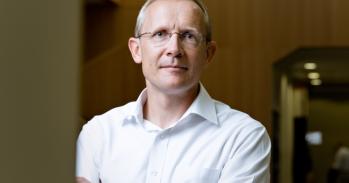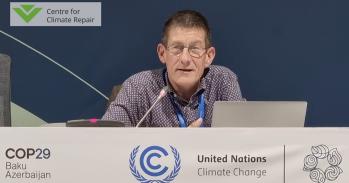
Some remarkable organisms are able to withstand almost complete desiccation. How they survive is providing Cambridge researchers with new ideas for biostable therapeutics.
Some remarkable organisms are able to withstand almost complete desiccation. How they survive is providing Cambridge researchers with new ideas for biostable therapeutics.
An understanding of the drying-without-dying trick is not only of scientific interest but could also have important medical applications. For example, many drugs and vaccines are fragile molecules that lose their potency if not kept cool.
Resurrection might seem an unpromising topic for scientific research, but there are well-characterised organisms, including some animals and plants, that are able to enter, and recover from, an apparently lifeless state. They can remain in suspended animation for long periods, perhaps for decades, but then resume their normal lives, apparently unaffected.
Life without water
Dr Alan Tunnacliffe, Reader in Biotechnology at the Department of Chemical Engineering and Biotechnology, and his research team are working on one means by which nature is able to cheat death. This is called anhydrobiosis, derived from the Greek for ‘life without water’, and occurs in organisms that are able to withstand almost complete desiccation.
The ability to survive extreme dehydration is remarkable for a living organism since it is widely accepted that life is water, and usually there is a limit beyond which further loss of water is fatal. Humans are typical in this respect, as water comprises approximately two-thirds of our body weight, and loss of just 15% of this is life threatening if not treated rapidly. Anhydrobiotic organisms, by contrast, are able to survive loss of most of their body water, which is reduced to 10% or less of body weight in the dried state. When dry, no signs of life can be detected: metabolism is completely shut down and only resumes when water is present once more.
When dry, anhydrobiotic creatures can tolerate an astonishing range of environmental stresses, including extremes of temperature and pressure: from –270°C, which is close to absolute zero, to +150°C, well above the boiling point of water; and from the vacuum of space to a thousand atmospheres in a pressure chamber. After this mistreatment, they can still be revived by rehydration without ill effect. It is perhaps not surprising that one proposal for how life originated on Earth is that anhydrobiotic organisms were carried through space from another planet.
Animal magic
One type of animal that can perform the anhydrobiosis trick is the bdelloid rotifer, a harmless, normally aquatic, creature that is less than a millimetre in size. Bdelloids are ubiquitous in freshwater environments throughout the world, particularly in temporary pools where the ability to survive desiccation offers a selective advantage.
Dr Tunnacliffe’s group is studying two different species of rotifer, one collected from a bird bath in his back garden, and the second from a billabong in Australia. They can be grown easily in the laboratory, feeding happily on bacteria or other small organic particles. They also reproduce asexually – no males have ever been found – so that large cultures can be derived from single individuals. This results in a population of genetically identical animals (a clone), and clones of many thousands of rotifers can be produced in the laboratory.
Other small animals are also able to undergo drying without dying, including some species of nematode worms, normally found in soil or on leaf litter, and thus frequently subjected to drought; these animals have also been adapted to life in the laboratory.
How do they do that?
The ready availability of large numbers of bdelloid rotifers and nematodes allows biochemical and genetic studies to be carried out that should eventually unravel the mystery of anhydrobiosis. Initial work has focused on simple sugars that are able to protect biological molecules against desiccation damage. Many of the plants that undergo anhydrobiosis, the aptly named resurrection plants, contain large quantities of sucrose – the same sugar used to sweeten tea or coffee. Researchers have discovered that another related sugar, trehalose, seems to be involved in protecting some animals and microorganisms from dehydration stress. Both sugars are thought to protect drying organisms by forming organic glasses inside cells and around sensitive molecules, trapping them in space and time.
Water-loving proteins
Other similar molecular magic tricks are sure to be discovered since bdelloid rotifers are now known from the group’s research to be unable to produce trehalose. One class of molecules that offers an alternative to the ‘sugar solution’ to the anhydrobiosis problem is that of water-loving (hydrophilic) proteins. Recent research in the Tunnacliffe lab has discovered such proteins in bdelloid rotifers and indeed many other desiccation-tolerant organisms, including plants and microorganisms.
A major problem for proteins in a drying cell is loss of three-dimensional (3D) structure, resulting in the proteins clumping together to form aggregates, which can be toxic to the cell. Hydrophilic proteins are unusual in that they lack a defined 3D structure and seem able to protect other proteins around them, either in the test tube or a living cell, from aggregation. Further work has shown that hydrophilic proteins might also offer protection to cell membranes during desiccation, and help to prevent cells becoming leaky under stress.
Biostable medicines
An understanding of the drying-without-dying trick is not only of scientific interest but could also have important medical applications. For example, many drugs and vaccines are fragile molecules that lose their potency if not kept cool. This limits their effectiveness in many developing countries, where refrigeration is not always available. The difficulty in maintaining a ‘cold chain’ from point of manufacture of a medicine to its point of use has been highlighted by the World Health Organization as a major hurdle in bringing some treatments, regarded as routine in the developed world, to less- developed regions. A technology that allows medicines to be dried, conferring on them the remarkable biostability of anhydrobiosis, could be of enormous benefit, and this approach is already being used by some vaccine manufacturers.
Dr Tunnacliffe has recently received funding from the European Research Council (ERC) to take this idea a step further. Understanding how a rotifer or nematode survives drying should allow the application of what has been learned in these organisms to a mammalian cell. Such driable-but-viable cells could have applications in tissue engineering where new cell-based therapeutics are envisaged. At the moment, for example, producing an artificial pancreas capable of secreting insulin in response to high blood sugar levels as a treatment for diabetics requires the handling of fragile live cells. If these cells could be dried in a viable form, the accompanying biostability should make such artificial organs more like off-the-shelf medicines, easy to store and with a long shelf life; rehydration could be performed just prior to use. Although this scenario currently sounds like science fiction, the humble, harmless rotifer is teaching us that it might not be too far away.
For more information, please contact the author Dr Alan Tunnacliffe (at10004@cam.ac.uk) at the Department of Chemical Engineering and Biotechnology.
This work is licensed under a Creative Commons Licence. If you use this content on your site please link back to this page.





